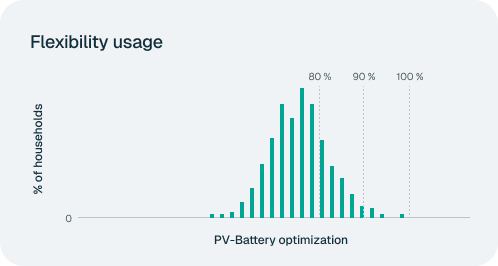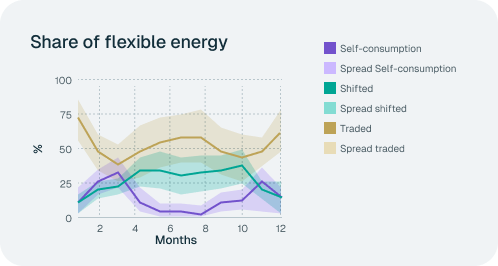Romande Energie transforms energy & imbalance cost savings into consumer value
Romande Energie explores the value of residential PV curtailment and PV-battery optimization as a tool to reduce energy and imbalance costs, and deliver end-user savings. By analysing the full value stack—behind-the-meter (BTM) and front-of-the-meter (FTM)—the goal is to understand how distributed energy assets can support both power system stability and customer benefit.
Why action was needed
Rapid growth in distributed assets
With the rise in residential electrification and decentralised systems, Romande Energie faces increased complexity in load forecasting and system balancing.
Regulatory Shifts & Tariff Innovation
Emerging regulatory frameworks enabled the use of dynamic feed-in and grid tariffs but their real impact on system value and customer incentives remained unclear. Romande Energie sought to explore how these evolving tariff structures could support flexibility, unlock new product potential, and align with market dynamics.
Market volatility & imbalance costs
The surge in solar and wind generation introduces greater variability in supply and demand. For Romande Energie, this is leading to rising imbalance costs, high-lighting the need for proactive flexibility strategies.

Client
Romande Energie is one of the largest Swiss energy suppliers. The company supplies energy, including from renewable sources, distributes energy and offers B2B and B2C consumer solutions around distributed energy resources. In these regards and with the increase in electrification, the leverage of flexibility plays an increasingly important role.
SOLUTION BY BEEBOP
Flexmap: Defining the total value stack & enabling customer product design
Flexibility mapping with Beebop
Beebop looked at the full optimisation stack, i.e. co-optimisation between different behind the meter objectives in synergy with upstream in front of the meter value streams. Based on this information, including contract characteristics, the potential flexibility and its cost were calculated. In alignment with Romande Energie, the monetisation opportunities and value stacking mechanisms had been agreed on. Beebop provided a shadow trading functionality to avoid the need for integration with Romande Energie trading operations or IT. As a result, the savings on imbalance costs and the revenue potential for new customer product design were determined.
Precision value mapping
Precise calculation of value of flexibility for each monetisation opportunity in front of and behind the meter.
Foundation for scalable business models
A solid basis to build a sustainable business case and business model for further decisions on customer product design.
Data-driven product innovation and investment decisions
A clear calculation of the imbalance costs that can be saved by leveraging PV curtailment.



The b2c customer proposition
Next step: Significant cost savings and innovative customer offerings
Together, Romande Energie and Beebop analysed the existing and future potential of flexibility, defining the implications and milestones for implementing new customer products - while significantly reducing costs.
What comes next
Based on the results provided by Beebop, Romande Energie is launching several initiatives to build the technical integration of distributed devices while at the same time shaping new and innovative customer offerings. The aim is to launch a product in 2026 and scale it across the customer base to match changing regulation and significantly reduce imbalance costs. The calculation of the potential revenues serves as a core element for any future product design.
25%
potential cost savings on imbalance costs
2
product and technical initiatives launched
100%
clarity on the available value of flexibility along the monetisation stack
Step into the power system of the future.

